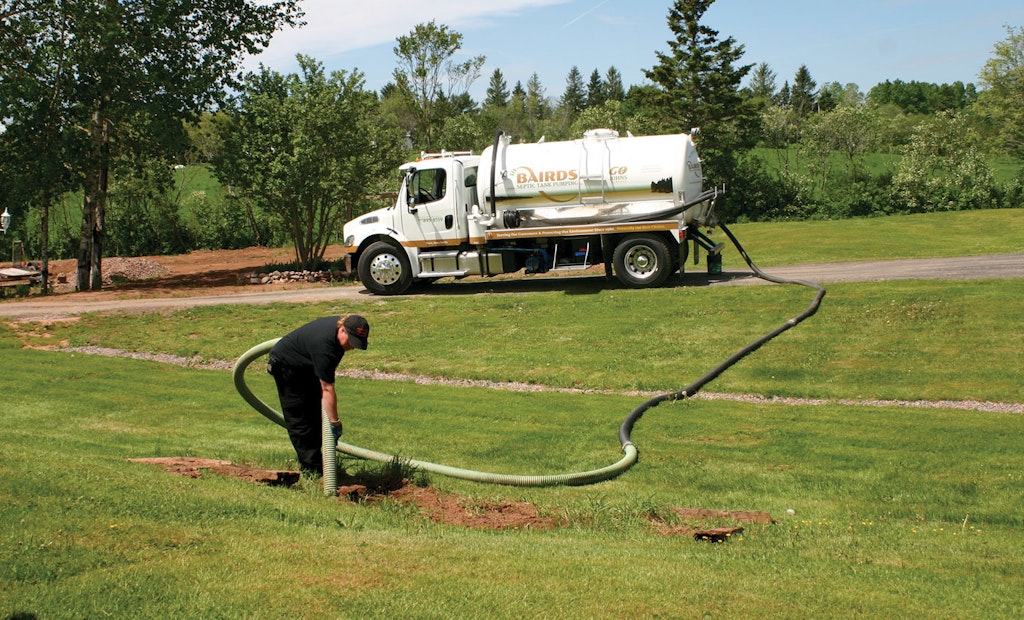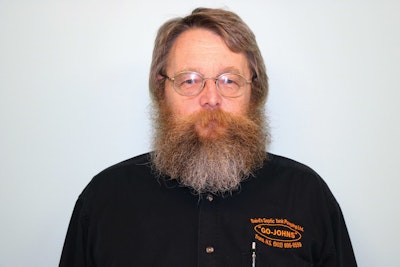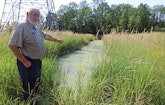
Technician Virginia Blondon outside a 2015 Freightliner M2 with a Vacutrux steel tank and Fruitland pump.
In States Snapshot, we visit with a member of a state, provincial or national trade association in the decentralized wastewater industry. This time we learn about a member of Waste Water Nova Scotia.
James Baxter - operations manager
Business: Baird’s Septic Tank Pumping, Upper Onslow, Nova Scotia
Age: 60
Years in the industry: 18
Association involvement: We’ve been members for quite some time in Waste Water Nova Scotia. Our owner, Allan Baird, and a couple other gentlemen had formed the Septic Pumpers Association of Nova Scotia in 1992. I was secretary and treasurer for many years. About 2008 we merged with Waste Water Nova Scotia, which was a much bigger organization and had a longer reach with the Department of Environment.
Benefits of belonging to the association: The association works closely with the Nova Scotia Department of Environment. It has a very good website. And it gets any news back to us faster than waiting for a letter from the department. We were probably the first province to require certification for every pumper and portable restroom operator.
Biggest issue facing your association right now: There are a couple issues — keeping up with the changes in regulations and inconsistencies with the various regional (Department of Environment) offices. What you can do in one region may not be accepted in a different region. It’s definitely something getting worked on. Another problem is people doing things “off the books” and not complying with regulations.
Our crew includes: Allan Baird, owner; Deanna Baird (Allan Baird’s daughter-in-law) in the office; Rob Mont, who handles portable restrooms; and septic drivers Derek Reynolds, Brian Allan, Virginia Blondon and Calvin Schellenberg
Typical day on the job: I’m usually at the office by 7 a.m., checking the phone for messages. If I feel real ambitious, I’ll even go onto the computer and look at the emails, but I usually wait for Deanna Baird to do that. And then I work on the assignments for the day before the drivers arrive — who’s to do what, where do they go, seeing which vehicles will be required. Then when Allan Baird is not around, I take his disabled 40-year-old daughter to and from work. During the rest of the day, I will answer the phone, do the bookkeeping, prepare checks, pay bills and troubleshoot problems that come up. I also help customers who call in with issues.
Helping hands – Indispensable crew member: As far as I’m concerned, everybody is indispensable. We all carry our weight; we all know what needs to be done and we make sure it gets done. It’s that simple.
The job I’ll never forget: Sometimes people don’t think before they do expansions or modifications to their property. There was a job where the owners had put an extension onto their house at ground level, and when the septic tank needed to be pumped, it was found underneath the bed in a bedroom. We had to move the bed, cut a hole in the floor and put the hose in through the window.
Most challenging site I’ve worked on: Coming up to spec for the updated Department of Environment regulations was a challenge. Everybody with a lagoon for disposal, whether private or municipal, had to come up to the new spec by the end of 2010, which meant a lot of upgrading for most everyone. It took us three years. That included building a completely new lagoon system to accept the material. We built it adjacent to our existing lagoon. The main change was size. It was double what we were used to.
We did the lion’s share of the work ourselves but did contract with people to bring in the gravel to build our drying pad and do the excavating and dozing. It was a juggling act because we knew people were down there working and we had to make sure we didn’t disrupt the flow of that work when we had to get into our existing disposal site. Our septic lagoon was the first one that has a discharge that goes through a natural filter system — cattails — through a maze. It was Allan Baird’s idea. He tossed it to an engineer who figured it out. The success of it was good enough that there have been four more installed in the province.
The craziest question I’ve been asked by a customer: A lady called to get her septic tank pumped and she asked me: “Why do I even have one of those things? I’m from Calgary and all we did was flush the toilet and it went away.” I had to explain what she had and why she had it. It’s understandable — Calgary is on a municipal system. In Nova Scotia, approximately 55 percent of the population is on onsite septic systems. I’ve talked to many people who were brought up on municipal systems and they don’t really understand the workings or maintenance requirements of a septic system. And just like when the province started promoting recycling and they put it into the education system and the children educated their parents, we strongly believe septic information should be in the education system and let the children educate their parents.
If I could change one industry regulation, it would be: I don’t think I would change anything so much as I want more enforcement. It’s all right to have a regulation, but it’s no good if it’s not enforced. For example, in this province you’re not allowed to land-apply unless it’s treated but there are some out there who are not exactly keeping up with that. Unless someone files a complaint, the department is not allowed to take any action.
If I wasn’t working in the wastewater industry, I would: Before this I worked as a contractor so that’s what I know. When people ask me how I got into this business, I always joke that it was the greatest mistake of my life. I read an ad in the paper but it didn’t tell me anything other than they needed certain skills, which I had. I came into the yard, I saw what it was and I had to decide: Do I put the brakes on or keep going? I put the brakes on, and it’s been the greatest thing that’s ever happened to me. It truly is a joy. The people in this industry are so friendly and helpful.
Crystal ball time – This is my outlook for the wastewater industry: I do believe onsite systems will be changing more. They’re probably going to go more toward treatment plant-type of ideas as opposed to the traditional field-bed ideas, and more homes tied into one system as opposed to having multiple systems. That would give better control for the authorities. Instead of looking at tens of thousands, they’ll be looking at thousands. I think we are going to see mandatory pumping. It exists in Norway and several regions in Quebéc where homeowners pay for the service in their taxes and the pumper is contracted by the municipality. I think we’ll see disposal going more toward dewatering. The problem with that is what do you do with the dewatered material? At a recent (Portable Sanitation Association International) convention in Florida, we went to a wastewater plant that is pelletizing the material into fertilizer, which has tremendous promise. The biggest issue with that is that to sell it, you have to disclose what it is and public perception of human waste is a major issue.







